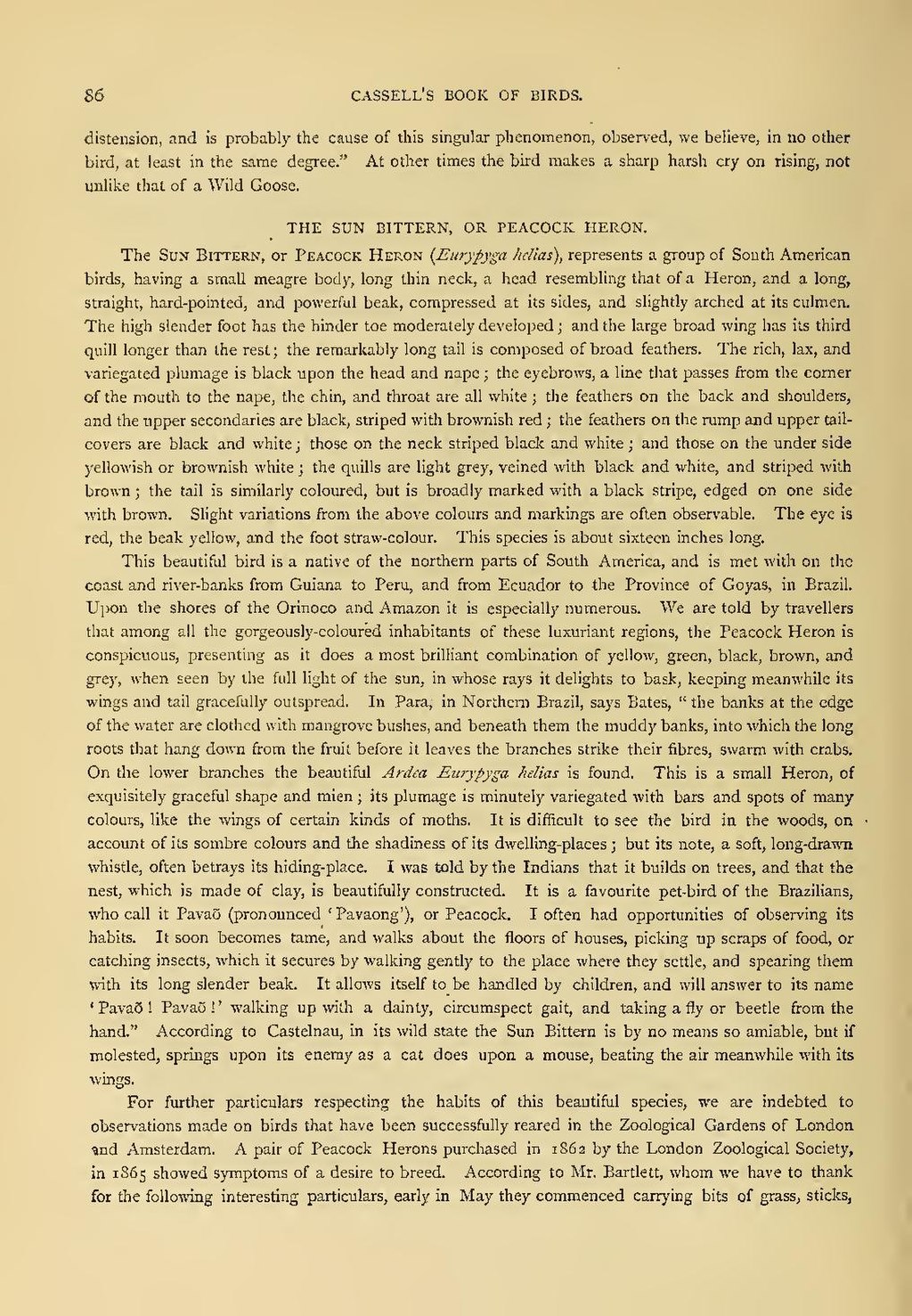distension, and is probably the cause of this singular phenomenon, observed, we believe, in no other bird, at least in the same degree." At other times the bird makes a sharp harsh cry on rising, not unlike that of a Wild Goose.
THE SUN BITTERN, OR PEACOCK HERON.
The Sun Bittern, or Peacock Heron (Eurypyga helias), represents a group of South American birds, having a small meagre body, long thin neck, a head resembling that of a Heron, and a long, straight, hard-pointed, and powerful beak, compressed at its sides, and slightly arched at its culmen. The high slender foot has the hinder toe moderately developed; and the large broad wing has its third quill longer than the rest; the remarkably long tail is composed of broad feathers. The rich, lax, and variegated plumage is black upon the head and nape; the eyebrows, a line that passes from the corner of the mouth to the nape, the chin, and throat are all white; the feathers on the back and shoulders, and the upper secondaries are black, striped with brownish red; the feathers on the rump and upper tail-covers are black and white; those on the neck striped black and white; and those on the under side yellowish or brownish white; the quills are light grey, veined with black and white, and striped with brown; the tail is similarly coloured, but is broadly marked with a black stripe, edged on one side with brown. Slight variations from the above colours and markings are often observable. The eye is red, the beak yellow, and the foot straw-colour. This species is about sixteen inches long.
This beautiful bird is a native of the northern parts of South America, and is met with on the coast and river-banks from Guiana to Peru, and from Ecuador to the Province of Goyas, in Brazil. Upon the shores of the Orinoco and Amazon it is especially numerous. We are told by travellers that among all the gorgeously-coloured inhabitants of these luxuriant regions, the Peacock Heron is conspicuous, presenting as it does a most brilliant combination of yellow, green, black, brown, and grey, when seen by the full light of the sun, in whose rays it delights to bask, keeping meanwhile its wings and tail gracefully outspread. In Para, in Northern Brazil, says Bates, "the banks at the edge of the water are clothed with mangrove bushes, and beneath them the muddy banks, into which the long roots that hang down from the fruit before it leaves the branches strike their fibres, swarm with crabs. On the lower branches the beautiful Ardea Eurypyga helias is found. This is a small Heron, of exquisitely graceful shape and mien; its plumage is minutely variegated with bars and spots of many colours, like the wings of certain kinds of moths. It is difficult to see the bird in the woods, on account of its sombre colours and the shadiness of its dwelling-places; but its note, a soft, long-drawn whistle, often betrays its hiding-place. I was told by the Indians that it builds on trees, and that the nest, which is made of clay, is beautifully constructed. It is a favourite pet-bird of the Brazilians, who call it Pavaõ (pronounced 'Pavaong'), or Peacock. I often had opportunities of observing its habits. It soon becomes tame, and walks about the floors of houses, picking up scraps of food, or catching insects, which it secures by walking gently to the place where they settle, and spearing them with its long slender beak. It allows itself to be handled by children, and will answer to its name 'Pavaõ! Pavaõ!' walking up with a dainty, circumspect gait, and taking a fly or beetle from the hand." According to Castelnau, in its wild state the Sun Bittern is by no means so amiable, but if molested, springs upon its enemy as a cat does upon a mouse, beating the air meanwhile with its wings.
For further particulars respecting the habits of this beautiful species, we are indebted to observations made on birds that have been successfully reared in the Zoological Gardens of London and Amsterdam. A pair of Peacock Herons purchased in 1862 by the London Zoological Society, in 1865 showed symptoms of a desire to breed. According to Mr. Bartlett, whom we have to thank for the following interesting particulars, early in May they commenced carrying bits of grass, sticks,
